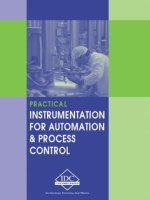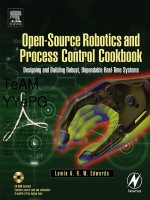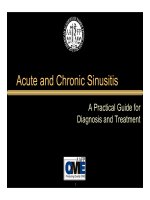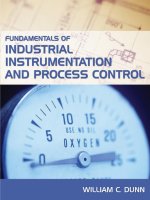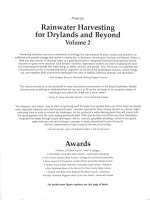Practical instrumentation for automation and process control 2
Bạn đang xem bản rút gọn của tài liệu. Xem và tải ngay bản đầy đủ của tài liệu tại đây (6.91 MB, 374 trang )
Presents
Practical
Instrumentation for Automation
and Process Control
for Engineers and Technicians
Web Site:
E-mail:
IDC Technologies
Technology Training that Works
Copyright
All rights to this publication, associated software and workshop are reserved. No part of
this publication or associated software may be copied, reproduced, transmitted or stored
in any form or by any means (including electronic, mechanical, photocopying, recording
or otherwise) without prior written permission of IDC Technologies.
Disclaimer
Whilst all reasonable care has been taken to ensure that the descriptions, opinions, programs,
listings, software and diagrams are accurate and workable, IDC Technologies do not accept
any legal responsibility or liability to any person, organization or other entity for any
direct loss, consequential loss or damage, however caused, that may be suffered as a result
of the use of this publication or the associated workshop and software.
In case of any uncertainty, we recommend that you contact IDC Technologies for
clarification or assistance.
Trademarks
All terms noted in this publication that are believed to be registered trademarks or trademarks
are listed below:
IBM, XT and AT are registered trademarks of International Business
Machines Corporation.
Microsoft, MS-DOS and Windows are registered trademarks of Microsoft Corporation.
Acknowledgements
IDC Technologies expresses its sincere thanks to all those engineers and technicians on
our training workshops who freely made available their expertise in preparing this manual.
IDC Technologies
Technology Training that Works
Who is IDC Technologies?
IDC Technologies is a specialist in the field of industrial communications,
telecommunications, automation and control and has been providing high quality training
for more than six years on an international basis from offices around the world.
IDC consists of an enthusiastic team of professional engineers and support staff who are
committed to providing the highest quality in their consulting and training services.
The Benefits to you of Technical Training Today
The technological world today presents tremendous challenges to engineers, scientists
and technicians in keeping up to date and taking advantage of the latest developments in
the key technology areas.
•
The immediate benefits of attending IDC workshops are:
•
Gain practical hands-on experience
•
Enhance your expertise and credibility
•
Save $$$s for your company
•
Obtain state of the art knowledge for your company
•
Learn new approaches to troubleshooting
•
Improve your future career prospects
The IDC Approach to Training
All workshops have been carefully structured to ensure that attendees gain maximum
benefits. A combination of carefully designed training software, hardware and well written
documentation, together with multimedia techniques ensure that the workshops are
presented in an interesting, stimulating and logical fashion.
IDC has structured a number of workshops to cover the major areas of technology. These
courses are presented by instructors who are experts in their fields, and have been attended
by thousands of engineers, technicians and scientists world-wide (over 11,000 in the past
two years), who have given excellent reviews. The IDC team of professional engineers is
constantly reviewing the courses and talking to industry leaders in these fields, thus keeping
the workshops topical and up to date.
IDC Technologies
Technology Training that Works
Technical Training Workshops
IDC is continually developing high quality state of the art workshops aimed at assisting
engineers, technicians and scientists. Current workshops include:
Instrumentation and Control
•
•
•
•
•
•
•
•
•
•
•
•
•
Practical Automation and Process Control using PLC’s
Practical Data Acquisition using Personal Computers and Standalone Systems
Practical On-line Analytical Instrumentation for Engineers and Technicians
Practical Flow Measurement for Engineers and Technicians
Practical Intrinsic Safety for Engineers and Technicians
Practical Safety Instrumentation and Shut-down Systems for Industry
Practical Process Control for Engineers and Technicians
Practical Programming for Industrial Control – using (IEC 1131-3;OPC)
Practical SCADA Systems for Industry
Practical Boiler Control and Instrumentation for Engineers and Technicians
Practical Process Instrumentation for Engineers and Technicians
Practical Motion Control for Engineers and Technicians
Practical Communications, SCADA & PLC’s for Managers
Communications
•
•
•
•
•
•
•
•
•
•
•
Practical Data Communications for Engineers and Technicians
Practical Essentials of SNMP Network Management
Practical FieldBus and Device Networks for Engineers and Technicians
Practical Industrial Communication Protocols
Practical Fibre Optics for Engineers and Technicians
Practical Industrial Networking for Engineers and Technicians
Practical TCP/IP & Ethernet Networking for Industry
Practical Telecommunications for Engineers and Technicians
Practical Radio & Telemetry Systems for Industry
Practical Local Area Networks for Engineers and Technicians
Practical Mobile Radio Systems for Industry
Electrical
•
•
•
•
•
•
Practical Power Systems Protection for Engineers and Technicians
Practical High Voltage Safety Operating Procedures for Engineers & Technicians
Practical Solutions to Power Quality Problems for Engineers and Technicians
Practical Communications and Automation for Electrical Networks
Practical Power Distribution
Practical Variable Speed Drives for Instrumentation and Control Systems
Project & Financial Management
•
•
•
Practical Project Management for Engineers and Technicians
Practical Financial Management and Project Investment Analysis
How to Manage Consultants
Mechanical Engineering
•
•
Practical Boiler Plant Operation and Management for Engineers and Technicians
Practical Centrifugal Pumps – Efficient use for Safety & Reliability
Electronics
•
•
•
•
Practical Digital Signal Processing Systems for Engineers and Technicians
Practical Industrial Electronics Workshop
Practical Image Processing and Applications
Practical EMC and EMI Control for Engineers and Technicians
INFORMATION TECHNOLOGY
•
•
•
Personal Computer & Network Security (Protect from Hackers, Crackers & Viruses)
Practical Guide to MCSE Certification
Practical Application Development for Web Based SCADA
IDC Technologies
Technology Training that Works
Comprehensive Training Materials
Workshop Documentation
All IDC workshops are fully documented with complete reference materials including
comprehensive manuals and practical reference guides.
Software
Relevant software is supplied with most workshop. The software consists of demonstration
programs which illustrate the basic theory as well as the more difficult concepts of the
workshop.
Hands-On Approach to Training
The IDC engineers have developed the workshops based on the practical consulting expertise
that has been built up over the years in various specialist areas. The objective of training
today is to gain knowledge and experience in the latest developments in technology through
cost effective methods. The investment in training made by companies and individuals is
growing each year as the need to keep topical and up to date in the industry which they are
operating is recognized. As a result, the IDC instructors place particular emphasis on the
practical hands-on aspect of the workshops presented.
On-Site Workshops
In addition to the quality of workshops which IDC presents on a world-wide basis, all IDC
courses are also available for on-site (in-house) presentation at our clients premises.
On-site training is a cost effective method of training for companies with many delegates to
train in a particular area. Organizations can save valuable training $$$’s by holding courses
on-site, where costs are significantly less. Other benefits are IDC’s ability to focus on
particular systems and equipment so that attendees obtain only the greatest benefits from
the training.
All on-site workshops are tailored to meet with clients training requirements and courses
can be presented at beginners, intermediate or advanced levels based on the knowledge
and experience of delegates in attendance. Specific areas of interest to the client can also
be covered in more detail.
Our external workshops are planned well in advance and you should contact us as early as
possible if you require on-site/customized training. While we will always endeavor to
meet your timetable preferences, two to three months notice is preferable in order to
successfully fulfil your requirements.
Please don’t hesitate to contact us if you would like to discuss your training needs.
IDC Technologies
Technology Training that Works
Customized Training
In addition to standard on-site training, IDC specializes in customized courses to meet
client training specifications. IDC has the necessary engineering and training expertise
and resources to work closely with clients in preparing and presenting specialized courses.
These courses may comprise a combination of all IDC courses along with additional topics
and subjects that are required. The benefits to companies in using training is reflected in
the increased efficiency of their operations and equipment.
Training Contracts
IDC also specializes in establishing training contracts with companies who require ongoing
training for their employees. These contracts can be established over a given period of
time and special fees are negotiated with clients based on their requirements. Where possible
IDC will also adapt courses to satisfy your training budget.
References from various international companies to whom IDC is contracted
to provide on-going technical training are available on request.
Some of the thousands of Companies world-wide that have supported and
benefited from IDC workshops are:
• Alcoa • Allen-Bradley • Altona Petrochemical • Aluminum Company of America • AMC
Mineral Sands • Amgen • Arco Oil and Gas • Argyle Diamond Mine • Associated Pulp and
Paper Mill • Bailey Controls • Bechtel • BHP Engineering • Caltex Refining • Canon •
Chevron • Coca-Cola • Colgate-Palmolive • Conoco Inc • Dow Chemical • ESKOM
• Exxon • Ford • Gillette Company • Honda • Honeywell • Kodak • Lever Brothers
• McDonnell Douglas • Mobil • Modicon • Monsanto • Motorola • Nabisco • NASA
• National Instruments • National Semi-Conductor • Omron Electric • Pacific Power
• Pirelli Cables • Proctor and Gamble • Robert Bosch Corp • Siemens • Smith Kline Beecham
• Square D • Texaco • Varian • Warner Lambert • Woodside Offshore Petroleum
• Zener Electric.
IDC Technologies
Technology Training that Works
Contents
Preface
1
xi
Introduction
1
1.1
1.2
1.3
1
2
1.4
1.5
1.6
1.7
1.8
2
Basic measurements and control concepts
Basic measurement performance terms and specifications
Advanced measurement performance terms and
specifications
Definition of terminology
Process and Instrumentation Diagram symbols
Effects of selection criteria
Measuring instruments and control valves as part of the
overall control system
Typical applications
3
6
8
11
22
23
25
2.1
2.2
2.3
2.4
2.5
2.6
2.7
2.8
3
Pressure Management
25
26
28
38
44
47
48
50
Principles of pressure management
Pressure sources
Pressure transducers and elements – mechanical
Pressure transducers and elements – electrical
Installation considerations
Impact on the overall control loop
Selection tables
Future technologies
Level Measurement
51
3.1
3.2
3.3
3.4
3.5
3.6
3.7
3.8
3.9
3.10
3.11
3.12
3.13
3.14
51
52
54
56
65
70
71
72
78
89
91
91
93
95
Principles of level measurement
Simple sight glasses and gauging rods
Buoyancy type
Hydrostatic pressure
Ultrasonic measurement
Radar measurement
Vibration switches
Radiation measurement
Electrical measurement
Density measurement
Installation considerations
Impact on the overall control loop
Selection tables
Future technologies
4
Temperature Measurement
4.1
4.2
4.3
4.4
4.5
4.6
4.7
4.8
4.9
4.10
4.11
5
Principles of temperature measurement
Thermocouples
Resistance Temperature Detectors
Thermistors
Liquid-in-glass, filled, bimetallic
Non contact pyrometers
Humidity
Installation considerations
Impact on the overall control loop
Selection tables
Future technologies
97
97
98
110
118
122
130
133
135
136
137
139
141
5.1
5.2
5.3
5.4
5.5
5.6
5.7
5.8
5.9
5.10
5.11
5.12
5.13
6
Flow Measurement
141
146
160
165
167
179
185
189
192
198
199
201
202
Principles of flow measurement
Differential pressure flowmeters
Open channel flow measurement
Variable area flowmeters
Oscillatory flow measurement
Magnetic flowmeters
Positive displacement
Ultrasonic flow measurement
Mass flow meters
Installation considerations
Impact on overall control loop
Selection tables
Future technologies
205
6.1
6.2
6.3
6.4
6.5
6.6
6.7
6.8
6.9
6.10
6.11
7
Control Valves
205
206
220
225
228
234
237
241
242
243
244
Principles of control valves
Sliding stem valves
Rotary valves
Control valve selection and sizing
Control valve characteristics/trim
Control valve noise and cavitation
Actuators and positioners operation
Valve benchset and stroking
Impact on the overall control loop
Selection tables
Future technologies
247
7.1
7.2
7.3
7.4
8
Other Process Considerations
247
253
263
264
The new smart instrument and field bus
Noise and earthing considerations
Materials of construction
Linearisation
Integration of the System
8.1
8.2
8.3
267
Calculation of individual instruments and total error for the system 267
Selection considerations
270
Testing and commissioning of the subsystems
273
8.4
9
Linearisation
264
Weightometers
277
9.1
9.2
9.3
9.4
9.5
9.6
Introduction
Weightometers
Calibrating and testing weightometers
Operator checks
Other types of weightometers and weighing systems
Electrical disturbances for weighing systems
277
284
289
293
294
304
Appendix A
Thermocouple Tables
307
Appendix B
Process Instrumentation Practical Exercises
383
Appendix C
Ultrasonic Level Measurement
405
Appendix D
Multiple Choice Questions
443
Appendix E
Practical Exercises for Equipment Kit A
449
Appendix F
Practical Exercises for Equipment Kit B
493
IDC Technologies
Technology Training that Works
Instrumentation for Automation and Process Control
Preface
Preface
This workshop and accompanying manual is intended for engineers and technicians who need
to have a practical knowledge for selecting and implementing industrial instrumentation
systems and control valves. It can be argued that a clear understanding and application of the
instrumentation and control valves systems is the most important factor in an efficient and
successful control system.
The objectives of the workshop and manual are for you to be able to:
Specify and design instrumentation systems.
Correctly select and size control valves for industrial use.
Understand the problems with installing measurement equipment.
Troubleshoot instrumentation systems and control valves.
Isolate and rectify instrumentation faults.
Understand most of the major technologies used for instrumentation and control valves.
The chapters are broken down as follows:
Chapter 1 Introduction
This gives an overview of basic measurement terms and concepts. A review is given of
process and instrumentation diagram symbols and places instrumentation and valves in the
context of a complete control system.
Chapter 2 Pressure Measurement
This section commences with a review of the basic terms of pressure measurement and moves
onto pressure sources. The various pressure transducers and elements are discussed with
reference to installation considerations.
Chapter 3 Level Measurement
The principles of level measurement are reviewed and the various techniques examined
ranging from simple sight glasses to density measurement. Installation considerations are
again discussed.
© Copyright IDC Technologies 2001
Page P.1
Preface
Practical Industrial Process Measurement
Chapter 4 Temperature Measurement
The principles of temperature measurement are discussed and the various transducers
examined ranging from thermocouples to non-contact pyrometers. Installation and impact on
the overall loop are also briefly discussed.
Chapter 5 Flow Measurement
Initially the basic principles of flow measurement are discussed and then each technique is
examined. This ranges from differential pressure flowmeters to mass flow meters. The
installation aspects are also reviewed.
Chapter 6 Control Valves
The principles of control valves are initially reviewed. Various types of valves ranging from
sliding stem valves to rotary valves are also discussed. Control valve selection and sizing,
characteristics and trim are also examined. The important issues of cavitation and noise are
reviewed. Installation considerations are noted.
Chapter 7 Other Process Considerations
The new technologies of smart instruments and FieldBus are discussed. The important issues
of noise and interference are then examined.
Chapter 8 Integration of the System
Issues such as calculation of individual instruments error and total error are reviewed. A final
summary of the selection considerations for instrumentation systems is discussed. The chapter
is completed with a summary of testing and commissioning issues.
A set of Appendices is included to support the material contained in the manual. These
include:
Appendix A
Appendix B
Appendix C
Appendix D
Appendix E
Thermocouple Tables
RTD Tables
Extracts from Supplier Specifications
Chemical Resistance Chart
Practical Sessions
Bibliography
A detailed bibliography at the end of the manual gives additional reading on the subject.
Page P.2
© Copyright IDC Technologies 2004
1
Introduction
IDC Technologies
Technology Training that Works
Instrumentation for Automation and Process Control
Introduction
Chapter 1
Introduction
In a time of constant and rapid technological development, it would be quite ambitious to
develop and present a course that claimed to cover each and every industrial measuring type
of equipment. This course is not intended to be an encyclopaedia of instrumentation and
control valves, but rather a training guide for gaining experience in this fast changing
environment.
This course is aimed at providing engineers, technicians and any other personnel involved
with process measurement, more experience in that field. It is also designed to give students
the fundamentals on analysing the process requirements and selecting suitable solutions for
their applications.
1.1
Basic Measurement and Control Concepts
The basic set of units used on this course is the SI unit system. This can be summarised in the
following table 1.1
Quantity
Length
Mass
Time
Current
Temperature
Voltage
Resistance
Capacitance
Inductance
Energy
Power
Frequence
Charge
Force
Magnetic Flux
Magnetic Flux
Density
Unit
metre
kilogram
second
ampere
degree Kelvin
volt
ohm
farad
henry
joule
watt
hertz
coulomb
newton
weber
webers/metre2
Abbreviation
m
kg
s
A
°K
V
Ω
F
H
J
W
Hz
C
N
Wb
Wb/m2
Table 1.1
SI Units.
© Copyright IDC Technologies 2004
Page 1.1
Introduction
1.2
Instrumentation for Automation and Process Control
Basic Measurement Performance Terms and Specifications
There are a number of criteria that must be satisfied when specifying process
measurement equipment. Below is a list of the more important specifications.
1.2.1
Accuracy
The accuracy specified by a device is the amount of error that may occur when
measurements are taken. It determines how precise or correct the measurements are
to the actual value and is used to determine the suitability of the measuring
equipment.
Accuracy can be expressed as any of the following:
-
error in units of the measured value
percent of span
percent of upper range value
percent of scale length
percent of actual output value
Figure 1.1
Accuracy Terminology.
Accuracy generally contains the total error in the measurement and accounts for
linearity, hysteresis and repeatability.
Page 1.2
© Copyright IDC Technologies 2004
Instrumentation for Automation and Process Control
Introduction
Reference accuracy is determined at reference conditions, ie. constant ambient
temperature, static pressure, and supply voltage. There is also no allowance for drift
over time.
1.2.2
Range of Operation
The range of operation defines the high and low operating limits between which the
device will operate correctly, and at which the other specifications are guaranteed.
Operation outside of this range can result in excessive errors, equipment malfunction
and even permanent damage or failure.
1.2.3
Budget/Cost
Although not so much a specification, the cost of the equipment is certainly a
selection consideration. This is generally dictated by the budget allocated for the
application. Even if all the other specifications are met, this can prove an inhibiting
factor.
1.3
Advanced Measurement Performance Terms and Specifications
More critical control applications may be affected by different response
characteristics. In these circumstances the following may need to be considered:
1.3.1
Hysteresis
This is where the accuracy of the device is dependent on the previous value and the
direction of variation. Hysteresis causes a device to show an inaccuracy from the
correct value, as it is affected by the previous measurement.
Figure 1.2
Hysteresis.
© Copyright IDC Technologies 2004
Page 1.3
Introduction
1.3.2
Instrumentation for Automation and Process Control
Linearity
Linearity is how close a curve is to a straight line. The response of an instrument to
changes in the measured medium can be graphed to give a response curve. Problems
can arise if the response is not linear, especially for continuous control applications.
Problems can also occur in point control as the resolution varies depending on the
value being measured.
Linearity expresses the deviation of the actual reading from a straight line. For
continuous control applications, the problems arise due to the changes in the rate the
output differs from the instrument. The gain of a non-linear device changes as the
change in output over input varies. In a closed loop system changes in gain affect
the loop dynamics. In such an application, the linearity needs to be assessed. If a
problem does exist, then the signal needs to be linearised.
Figure 1.3
Linearity.
1.3.3
Repeatability
Repeatability defines how close a second measurement is to the first under the same
operating conditions, and for the same input. Repeatability is generally within the
accuracy range of a device and is different from hysteresis in that the operating
direction and conditions must be the same.
Continuous control applications can be affected by variations due to repeatability.
When a control system sees a change in the parameter it is controlling, it will adjust
its output accordingly. However if the change is due to the repeatability of the
measuring device, then the controller will over-control. This problem can be
overcome by using the deadband in the controller; however repeatability becomes a
problem when an accuracy of say, 0.1% is required, and a repeatability of 0.5% is
present.
Page 1.4
© Copyright IDC Technologies 2004
Instrumentation for Automation and Process Control
Introduction
Figure 1.4
Repeatability.
Ripples or small oscillations can occur due to overcontrolling. This needs to be
accounted for in the initial specification of allowable values.
1.3.4
Response
When the output of a device is expressed as a function of time (due to an applied
input) the time taken to respond can provide critical information about the suitability
of the device. A slow responding device may not be suitable for an application. This
typically applies to continuous control applications where the response of the device
becomes a dynamic response characteristic of the overall control loop. However in
critical alarming applications where devices are used for point measurement, the
response may be just as important.
© Copyright IDC Technologies 2004
Page 1.5
Introduction
Instrumentation for Automation and Process Control
Figure 1.5
Typical time response for a system with a step input.
1.4
Definition of Terminology
Below is a list of terms and their definitions that are used throughout this manual.
Accuracy
How precise or correct the measured value is to the actual value. Accuracy is an
indication of the error in the measurement.
Ambient
The surrounds or environment in reference to a particular point or object.
Attenuation
A decrease in signal magnitude over a period of time.
Calibrate
To configure a device so that the required output represents (to a defined degree of
accuracy) the respective input.
Closed loop
Relates to a control loop where the process variable is used to calculate the controller
output.
Page 1.6
© Copyright IDC Technologies 2004
Instrumentation for Automation and Process Control
Introduction
Coefficient, temperature
A coefficient is typically a multiplying factor. The temperature coefficient defines
how much change in temperature there is for a given change in resistance (for a
temperature dependent resistor).
Cold junction
The thermocouple junction which is at a known reference temperature.
Compensation
A supplementary device used to correct errors due to variations in operating
conditions.
Controller
A device which operates automatically to regulate the control of a process with a
control variable.
Elastic
The ability of an object to regain its original shape when an applied force is
removed. When a force is applied that exceeds the elastic limit, then permanent
deformation will occur.
Excitation
The energy supply required to power a device for its intended operation.
Gain
This is the ratio of the change of the output to the change in the applied input. Gain
is a special case of sensitivity, where the units for the input and output are identical
and the gain is unitless.
Hunting
Generally an undesirable oscillation at or near the required setpoint. Hunting
typically occurs when the demands on the system performance are high and possibly
exceed the system capabilities. The output of the controller can be overcontrollerd
due to the resolution of accuracy limitations.
Hysteresis
The accuracy of the device is dependent on the previous value and the direction of
variation. Hysteresis causes a device to show an inaccuracy from the correct value,
as it is affected by the previous measurement.
Ramp
Defines the delayed and accumulated response of the output for a sudden change in
the input.
Range
The region between the specified upper and lower limits where a value or device is
defined and operated.
© Copyright IDC Technologies 2004
Page 1.7
Introduction
Instrumentation for Automation and Process Control
Reliability
The probability that a device will perform within its specifications for the number of
operations or time period specified.
Repeatability
The closeness of repeated samples under exact operating conditions.
Reproducibility
The similarity of one measurement to another over time, where the operating
conditions have varied within the time span, but the input is restored.
Resolution
The smallest interval that can be identified as a measurement varies.
Resonance
The frequency of oscillation that is maintained due to the natural dynamics of the
system.
Response
Defines the behaviour over time of the output as a function of the input. The output
is the response or effect, with the input usually noted as the cause.
Self Heating
The internal heating caused within a device due to the electrical excitation. Selfheating is primarily due to the current draw and not the voltage applied, and is
typically shown by the voltage drop as a result of power (I2R) losses.
Sensitivity
This defines how much the output changes, for a specified change in the input to the
device.
Setpoint
Used in closed loop control, the setpoint is the ideal process variable. It is
represented in the units of the process variable and is used by the controller to
determine the output to the process.
Span Adjustment
The difference between the maximum and minimum range values. When provided
in an instrument, this changes the slope of the input-output curve.
Steady state
Used in closed loop control where the process no longer oscillates or changes and
settles at some defined value.
Page 1.8
© Copyright IDC Technologies 2004
Instrumentation for Automation and Process Control
Introduction
Stiction
Shortened form of static friction, and defined as resistance to motion. More
important is the force required (electrical or mechanical) to overcome such a
resistance.
Stiffness
This is a measure of the force required to cause a deflection of an elastic object.
Thermal shock
An abrupt temperature change applied to an object or device.
Time constant
Typically a unit of measure which defines the response of a device or system. The
time constant of a first order system is defined as the time taken for the output to
reach 63.2% of the total change, when subjected to a step input change.
Transducer
An element or device that converts information from one form (usually physical,
such as temperature or pressure) and converts it to another ( usually electrical, such
as volts or millivolts or resistance change). A transducer can be considered to
comprise a sensor at the front end (at the process) and a transmitter.
Transient
A sudden change in a variable which is neither a controlled response nor long
lasting.
Transmitter
A device that converts from one form of energy to another. Usually from electrical
to electrical for the purpose of signal integrity for transmission over longer distances
and for suitability with control equipment.
Variable
Generally, this is some quantity of the system or process. The two main types of
variables that exist in the system are the measured variable and the controlled
variable. The measured variable is the measured quantity and is also referred to as
the process variable as it measures process information. The controlled variable is
the controller output which controls the process.
Vibration
This is the periodic motion (mechanical) or oscillation of an object.
Zero adjustment
The zero in an instrument is the output provided when no, or zero input is applied.
The zero adjustment produces a parallel shift in the input-output curve.
© Copyright IDC Technologies 2004
Page 1.9
